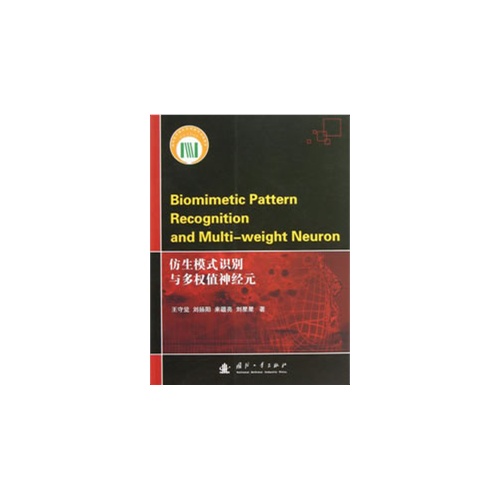- ISBN:9787118080810
- 装帧:一般胶版纸
- 册数:暂无
- 重量:暂无
- 开本:16开
- 页数:167
- 出版时间:2012-12-01
- 条形码:9787118080810 ; 978-7-118-08081-0
本书特色
王守觉编著的《仿生模式识别与多权值神经元》简介:This book is the second one after the first book named "First Step to Multi-Dimensional Space Biomimetic Informatics"(in Chinese), which are both illuminating the novel biomimetic high-dimensional space geometry computing theory, but this book is more detailed and systemic. This book consists of three parts, statistical pattern recognition, biomimetic pattern recognition and multi-weight neuron. Biomimetic Pattern Recognition and Multi-weight Neuron are proposed by academician Shoujue Wang at the start of representing digital data over hundreds of dimensionality as points, and developed for five years with many applications in many fields so far.
内容简介
this book is the second one after the first book named "first step to multi-dimensional space biomimetic informatics"(in chinese), which are both illuminating the novel biomimetic high-dimensional space geometry computing theory, but this book is more detailed and systemic. this book consists of three parts, statistical pattern recognition, biomimetic pattern recognition and multi-weight neuron. biomimetic pattern recognition and multi-weight neuron are proposed by academician shoujue wang at the start of representing digital data over hundreds of dimensionality as points, and developed for five years with many applications in many fields so far.
目录
part i review of statistics pattern recognition
chapter 1 introduction of pattern recognition
1.1 pattern recognition concept
1.2 pattern recognition system biasic processes
1.3 a brief survey of pattern recognition appro aches
1.4 scope and organization
chapter 2 kernel of statistical pattern recognition andpre-precessing
2.1 question arise
2.1.1 question expression
2.1.2 empirical risk minimization
2.1.3 generalization ability and complexity
2.2 kernel of statistical pattern recognition
2.2.1 vapnik-chervonenkis dimension
2.2.2 the bounds of generalization ability
2.2.3 the minimization of structural risk
2.3 preprocessin9
2.4 feature extraction and feature selection
2.4.1 curse of dimensionality
2.4.2 feature extraction
2.4.3 feature selection
2.5 support vector manchine
2.5.1 the optimal hyperplane under linearly separable
2.5.2 the soft spacing under linearly nonseparable
2.5.3 the kernel function under non-linear case
2.5.4 support vector machine's traits and advantages
references
part ii biomimetic pattern recognition
chapter 3 introduction
chapter 4 the foundation of biomimetic pattern recognition
4.1 overview of high-dimensional biomimetic informatics
4.1.1 the proposal of the problem of computer imaginalthinking
4.1.2 the principle of high-dimensional biomimeticinformatics
4.2 basic contents of high-dimensional biomimetic informatics
4.3 main features of high-dimensional giomimetic informatics
4 4 concepts and mathematical symbols in high-dimensionalbiomimetic informatics
4.4.1 concepts and definitions
4.4.2 mathematical symbols
4.4.3 symbolic computing methods in resolving geometry computingproblems
4.4.4 several applications in solving complicated geometrycomputing problems
4.5 some applications
4.5.1 blurred image restoration
4.5.2 uneven lighting image correction
4.5.3 removing facial makeup disturbances
chapter 5 the theory of biomimetic pattern recognition
5.1 the concept of biomimetic pattern recognition
5.2 the choice of the name
5.3 the developments of biomimetic pattern recognition
5.4 covering.the concept of recognition in biomimetic patternrecognition
5.5 the principle of homology-continuity: the starting point ofbiomimetic pattern recognition
5.6 expansionary product
5.7 experiments
5.7.1 the architecture of the face recognition system
5.7.2 umist face data
5.7.3 pre-treatment
5.7.4 the realization of svm face recognition algorithms
5.7.5 the realization of bpr face recognition algorithms
5.7.6 experiments results and analyzes
5.8 summary
chapter 6 applications
6.1 object recognition
6 2 a multi-camera human-face personal identification system
6.3 a recognition system for speaker-independent continuousspeech
6.4 summary
references
part ⅲ multi-weight neurons and networks
chapter 7 history and definations of artificial neuralnetworks
7.1 from biological neural networks to artificial neural networksand its development
7.2 some definitions and concepts of artificial neuralnetworks
7.3 unifications and divergences between array-processors andneural networks
7.4 artificial neural networks' effects on nanoelectronicalcomputational technology
chapter 8 geometric concepts of artificial neurons
8.1 mathematical expressions of common neurons and their geometricconcepts
8.2 general mathematical model of common neurons and its geometricconcept
8.3 direction basis function neuron and its geometric concept
8.4 multi-threshold neurons and networks
chapter 9 multi-weight neurons and their applications
9.1 general mathematical expression of multi-weight neurons'functions
9.2 interchangeabilities of points, vectors, hyper planes inhigh-dimensional space
9.3 effect of high-dimensional point distribution ana
-

造神:人工智能神话的起源和破除 (精装)
¥32.7¥88.0 -

大数据技术导论(第2版)
¥28.9¥41.0 -

人人都能学AI
¥40.4¥68.0 -

人工智能
¥20.3¥55.0 -

系统架构设计师教程(第2版)(全国计算机技术与软件专业技术资格(水平)考试指定用
¥102.7¥158.0 -

过程控制技术(第2版高职高专规划教材)
¥27.6¥38.0 -

数据结构基础(C语言版)(第2版)
¥41.7¥49.0 -

WPS OFFICE完全自学教程(第2版)
¥97.3¥139.0 -

智能视频目标检测与识别技术
¥43.5¥59.0 -

人工智能基础及应用
¥36.0¥48.0 -

深入浅出软件架构
¥117.2¥186.0 -

计算机网络基础(微课版)
¥39.0¥55.0 -

剪映:即梦AI绘画与视频制作从新手到高手
¥66.0¥89.0 -

红蓝攻防 技术与策略(原书第3版)
¥95.9¥139.0 -

Web前端开发基础
¥37.5¥57.0 -

软件设计的哲学(第2版)
¥52.0¥69.8 -

人工智能的底层逻辑
¥58.7¥79.0 -

软件工程理论与案例
¥63.4¥99.0 -

剪映+PREMIERE+AIGC 短视频制作速成
¥73.5¥98.0 -

剪映AI
¥52.0¥88.0














